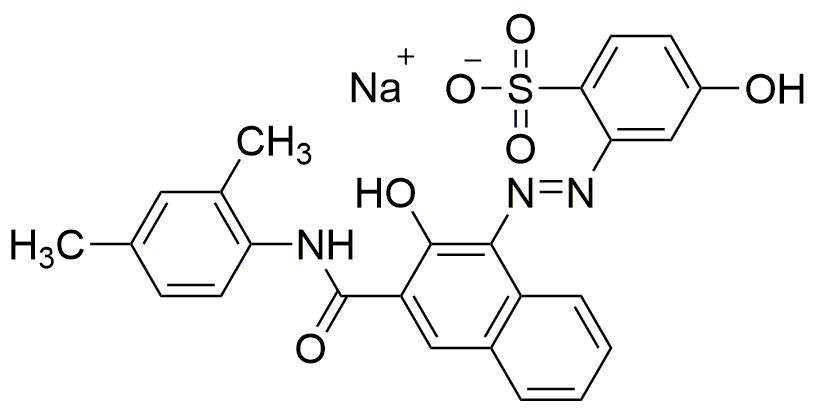Xylidyl blue I is widely utilized in research focused on:
- Dyeing and Pigmentation: This chemical is commonly used in the textile industry for dyeing fabrics, providing vibrant colors that are resistant to fading. Its stability makes it ideal for long-lasting applications.
- Biological Staining: In histology and microbiology, it serves as a dye for staining cells and tissues, enhancing visibility under a microscope. This application is crucial for researchers studying cellular structures and functions.
- Analytical Chemistry: Xylidyl blue I is employed as a reagent in various analytical methods, including spectrophotometry. Its ability to produce distinct color changes helps in the detection and quantification of other substances.
- Environmental Monitoring: The compound is used in assessing water quality, as it can indicate the presence of certain pollutants. This application is vital for environmental scientists working on pollution control and remediation.
- Cosmetic Formulations: It finds use in cosmetic products, providing color and aesthetic appeal. Its safety profile makes it suitable for formulations intended for skin contact, meeting consumer demands for vibrant and safe products.
General Information
Properties
Safety and Regulations
Applications
Xylidyl blue I is widely utilized in research focused on:
- Dyeing and Pigmentation: This chemical is commonly used in the textile industry for dyeing fabrics, providing vibrant colors that are resistant to fading. Its stability makes it ideal for long-lasting applications.
- Biological Staining: In histology and microbiology, it serves as a dye for staining cells and tissues, enhancing visibility under a microscope. This application is crucial for researchers studying cellular structures and functions.
- Analytical Chemistry: Xylidyl blue I is employed as a reagent in various analytical methods, including spectrophotometry. Its ability to produce distinct color changes helps in the detection and quantification of other substances.
- Environmental Monitoring: The compound is used in assessing water quality, as it can indicate the presence of certain pollutants. This application is vital for environmental scientists working on pollution control and remediation.
- Cosmetic Formulations: It finds use in cosmetic products, providing color and aesthetic appeal. Its safety profile makes it suitable for formulations intended for skin contact, meeting consumer demands for vibrant and safe products.
Documents
Safety Data Sheets (SDS)
The SDS provides comprehensive safety information on handling, storage, and disposal of the product.
Product Specification (PS)
The PS provides a comprehensive breakdown of the product’s properties, including chemical composition, physical state, purity, and storage requirements. It also details acceptable quality ranges and the product's intended applications.
Certificates of Analysis (COA)
Search for Certificates of Analysis (COA) by entering the products Lot Number. Lot and Batch Numbers can be found on a product’s label following the words ‘Lot’ or ‘Batch’.
*Catalog Number
*Lot Number
Certificates Of Origin (COO)
This COO confirms the country where the product was manufactured, and also details the materials and components used in it and whether it is derived from natural, synthetic, or other specific sources. This certificate may be required for customs, trade, and regulatory compliance.
*Catalog Number
*Lot Number
Safety Data Sheets (SDS)
The SDS provides comprehensive safety information on handling, storage, and disposal of the product.
DownloadProduct Specification (PS)
The PS provides a comprehensive breakdown of the product’s properties, including chemical composition, physical state, purity, and storage requirements. It also details acceptable quality ranges and the product's intended applications.
DownloadCertificates of Analysis (COA)
Search for Certificates of Analysis (COA) by entering the products Lot Number. Lot and Batch Numbers can be found on a product’s label following the words ‘Lot’ or ‘Batch’.
*Catalog Number
*Lot Number
Certificates Of Origin (COO)
This COO confirms the country where the product was manufactured, and also details the materials and components used in it and whether it is derived from natural, synthetic, or other specific sources. This certificate may be required for customs, trade, and regulatory compliance.


